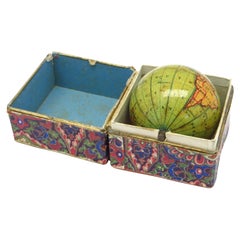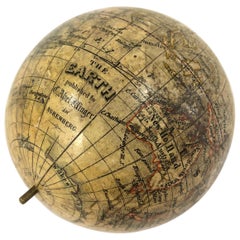Michael Manning Globes
Michael Manning is a studio artist working primarily as a painter with additional work focused on sculptures using repurposed materials and most recently Social Practice Art projects. He earned his BFA from the University of the Arts and an MFA from Montclair State University. Originally from the Philadelphia area, Manning has lived in numerous locations including, New York, San Francisco, Chicago and has worked extensively in German and Italy, collaborating with artists Eckhard Zylla and Reiner Gramlic, collectivity known as Six Hand Painting. His artwork has been part of numerous regional and international exhibitions. Solo and group exhibitions in Haus der Kunst Museum in Munich, Germany; Arnot Art Museum, Elmira, NY; University of Connecticut; Seton Hall University; The Flinn Gallery, Greenwich, CT; New York galleries including Pablo's Birthday and HP Garcia Gallery; Kohler, The Art of Inspiration Project; Red Bull, Kaustner and Partners; W-Hotel, New York, NY and other corporate collections and private collection.
to
1
1
1
1
1
1
1
1
1
1
1
1
4
22
8
5
5
Creator: Michael Manning
Miniature pocket globe in colourful card box
By Michael Manning
Located in ZWIJNDRECHT, NL
Miniature terrestrial pocket globe. Model of the earth.
London, 1857 by J. Manning
diameter of 1,75 inches / 4,5 cm.
This lovely miniature terrestrial globe consists of twelve copper engraved, hand coloured gores over a wooden base. The gores are varnished. The colouring is both subtle and original. With a central pin contained in a colourful card box.
A little about miniature globes: The miniature or pocket globe was a British invention, introduced to the world by Joseph Moxon in 1673 when he produced a 3-inch globe. To own a pocket globe is to have the whole world in miniature. Pocket globes were never to be taken very seriously – they never served any practical purpose; their size makes accurate calculations impossible, and they tend to lack the rings and dials for most common manipulations. No, they were seen more as a status symbol, or a lovely decorative artistic artefact to reside on a gentleman’s desk or small table. There is a school of thought that some of the cheaper pocket globes may have aided children’s education. Today, they reflect a lost and never-to-be-forgotten age of exploration...
Category
19th Century British Early Victorian Antique Michael Manning Globes
Materials
Hardwood, Paper
Related Items
1960's World Globe Dry Bar - Globe Opens to Reveal Storage
Located in Opa Locka, FL
1960's Large World Globe Dry Bar Storage. On rollers, the top opens to reveal interior dry bar storage area. Very good condition.
Category
1960s American Mid-Century Modern Vintage Michael Manning Globes
Materials
Wood
19th Century German Miniature Pocket Terrestrial Globe
By C. Abel-Klinger
Located in Essex, MA
A miniature 19th century 3.5 inch diameter pocket terrestrial globe by C. Abel-Klinger, Nuremberg, Germany, in English for the English speaking markets. Signed with cartouche reading...
Category
1880s German Antique Michael Manning Globes
Materials
Brass
Replogle Globe Vintage 16" World Classic Globe, LeRoy M Tolman Cartographer
By Replogle Globes
Located in Stamford, CT
Experience a piece of history with this vintage Replogle Globe, LeRoy M. Tolman cartographer. This 16-inch diameter World Classic series globe offers a timeless and detailed view of ...
Category
Late 20th Century American Michael Manning Globes
Materials
Wood
$446 Sale Price
25% Off
H 31 in Dm 22.5 in
German Political Globe
Located in Vienna, AT
German political globe. Fitted with E27 socket from the 1950s.
Category
1950s German Vintage Michael Manning Globes
Materials
Glass, Wood
globe globe globe design guido cora for paravia 1920 - early 1900s
By Paravia
Located in taranto, IT
extremely rare early 20th century world map made by Paravia Italia on illustrations by Guido Cora, one of the most important illustrators ever.
Made of parchment-coated material, cas...
Category
1920s Italian Industrial Vintage Michael Manning Globes
Materials
Metal
W. & A.K. Johnston 8" Globe
Located in Brooklyn, NY
This antique globe was made by W. & A.K. Johnston, a Scottish firm founded in 1825. Set inside a cast iron stand with claw feet. The globe can spin as well as revolve around using th...
Category
Early 20th Century Michael Manning Globes
Materials
Cast Stone
Tellus Globe, Ochre
Located in London, GB
This striking piece features a 500mm diameter globe elevated on a rippled Australian walnut veneered stand with caps, brace detailing and a highly polished base in antiqued brass. Th...
Category
2010s British Michael Manning Globes
Materials
Brass
Retro Walnut Globe
Located in Paris, FR
Globe retro walnut with base structure with solid
beech wood feet and with circled structure in African
walnut wood. Globe in beige finish with aluminium
meridian in brass finish.
Category
21st Century and Contemporary Italian Michael Manning Globes
Materials
Beech, Walnut
Late 19th Century English Victorian World Globe
Located in Queens, NY
English Victorian globe of the world on wrought iron filigree 3 legged base.
Category
Late 19th Century British Victorian Antique Michael Manning Globes
Materials
Iron
18-inch Globe, Cary's, London, 1840
By Cary’s
Located in Milano, IT
John and William Cary
Updated by George and John Cary
Terrestrial Globe
London, 1840
lb 22 (kg 10)
Slight surface abrasions due to use. A small crack on the horizon circle.
The globe rests in its original Dutch style stand with four supporting turned wood columns.
It measures 26 in in height x 23.6 in in diameter with the diameter of the sphere measuring 18 in; 66 cm in height x 60 cm in diameter with the diameter of the sphere measuring 45.72 cm.
The 18 inch...
Category
1840s English Early Victorian Antique Michael Manning Globes
Materials
Paper, Wood
Antique 19th Century Miniature French Edition Globe by C. Abel-Klinger
By C. Abel-Klinger
Located in Philadelphia, PA
A fine antique French Edition miniature globe.
By C. Abel-Klinger.
On a turned wooden stand with an uncalibrated brass half meridian.
The globe is marked with an integral l...
Category
19th Century German Neoclassical Antique Michael Manning Globes
Materials
Paper
Large Terrestrial Globe
Located in London, England
Large French table top terrestrial globe. Circa 1900
H 89cm x W 51cm x D 51cm
Category
Early 1900s French French Provincial Antique Michael Manning Globes
Materials
Steel
Michael Manning globes for sale on 1stDibs.
Michael Manning globes are available for sale on 1stDibs. These distinctive items are frequently made of wood and are designed with extraordinary care. Many of the original globes by Michael Manning were created in the Victorian style in united kingdom during the 19th century. If you’re looking for additional options, many customers also consider globes by and Cary’s. Prices for Michael Manning globes can differ depending upon size, time period and other attributes — on 1stDibs, these items begin at $3,268 and can go as high as $3,268, while a piece like these, on average, fetch $3,268.


